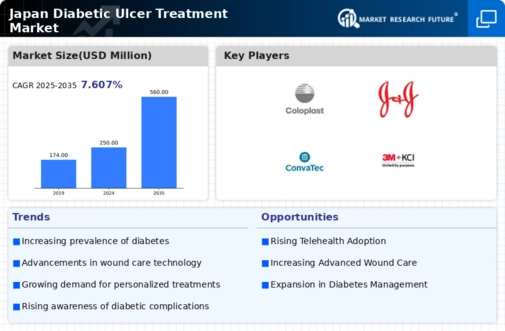Rising Prevalence of Diabetes
The increasing prevalence of diabetes in Japan is a critical driver for the diabetic ulcer-treatment market. As of recent estimates, approximately 7.4 million individuals in Japan are diagnosed with diabetes, leading to a heightened risk of complications such as diabetic ulcers. This growing patient population necessitates effective treatment options, thereby propelling market growth. The diabetic ulcer-treatment market is likely to expand as healthcare providers seek innovative solutions to manage and treat these ulcers, which can significantly impact patients' quality of life. Furthermore, the aging population in Japan, which is projected to reach 36% by 2040, exacerbates the situation, as older adults are more susceptible to diabetes and its complications. Consequently, the demand for advanced treatment modalities is expected to rise, driving the market forward.
Growing Awareness and Education
There is a notable increase in awareness and education regarding diabetes management and ulcer prevention in Japan. Various health organizations and government initiatives are actively promoting education programs aimed at both healthcare professionals and patients. This heightened awareness is crucial for the diabetic ulcer-treatment market, as it encourages early detection and timely intervention, which are essential for effective treatment. The diabetic ulcer-treatment market is likely to benefit from these educational efforts, as informed patients are more likely to seek appropriate care and adhere to treatment protocols. Furthermore, community outreach programs that focus on lifestyle modifications and self-management strategies are expected to reduce the incidence of diabetic ulcers, thereby driving demand for treatment options. As awareness continues to grow, the market is poised for expansion.
Increased Healthcare Expenditure
Japan's healthcare expenditure has been on the rise, which positively influences the diabetic ulcer-treatment market. The government allocated approximately ¥42 trillion to healthcare in 2025, reflecting a commitment to improving health services and patient care. This increase in funding allows for better access to advanced treatment options for diabetic ulcers, including specialized wound care clinics and innovative therapies. The diabetic ulcer-treatment market benefits from this heightened investment, as healthcare providers can adopt new technologies and treatment modalities that enhance patient outcomes. Moreover, the focus on preventive care and early intervention strategies is likely to reduce the incidence of diabetic ulcers, further stimulating market growth. As healthcare spending continues to rise, the market is expected to expand, driven by the demand for effective and efficient treatment solutions.
Advancements in Wound Care Technologies
Technological innovations in wound care are transforming the diabetic ulcer-treatment market. The introduction of advanced dressings, such as hydrocolloids and bioengineered skin substitutes, enhances healing rates and reduces infection risks. In Japan, the market for advanced wound care products is projected to grow at a CAGR of 8.5% from 2025 to 2030, indicating a robust demand for effective treatment solutions. These advancements not only improve patient outcomes but also reduce healthcare costs associated with prolonged treatment. The diabetic ulcer-treatment market is witnessing a shift towards more sophisticated technologies, including telemedicine and digital health solutions, which facilitate remote monitoring and management of diabetic ulcers. This trend suggests that the integration of technology into treatment protocols will likely continue to drive market growth in the coming years.
Aging Population and Associated Health Challenges
Japan's aging population presents unique challenges that significantly impact the diabetic ulcer-treatment market. With a projected 36% of the population aged 65 and older by 2040, the prevalence of chronic conditions, including diabetes, is expected to rise. Older adults are particularly vulnerable to developing diabetic ulcers due to factors such as reduced mobility and comorbidities. This demographic shift necessitates a robust response from the healthcare system, leading to increased demand for specialized treatment options. The diabetic ulcer-treatment market is likely to see growth as healthcare providers adapt to the needs of this aging population, focusing on tailored treatment plans and comprehensive care strategies. Additionally, the integration of geriatric care into diabetes management programs may further enhance treatment outcomes, driving market expansion.















Leave a Comment